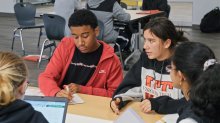Using Project-Based Learning to Prepare Students for Cutting-Edge Careers
Hoping to prepare high school graduates to solve complex, real-world problems, an Ohio STEM school found answers in project-based learning.
Your content has been saved!
Go to My Saved Content.When the community of Dayton, Ohio—charged in 2008 with founding a STEM high school—pondered how to bring life to its mission of connecting students to real-world outcomes, they didn’t need to look far. Within Dayton city limits, employers like GE Aviation, Wright-Patterson Air Force Base, and Kettering Health Network were seeking employees who could be, in the words of the Ohio Department of Education, “innovators and inventors, self-reliant and logical thinkers, and technologically proficient problem solvers.” The area was rich with opportunities in applied science and mathematics.
In other words, local industry was looking for just the type of inquisitive STEM student that the Dayton Regional STEM School was trying to develop. To connect the dots, educators at the school adopted a project-based learning (PBL) approach to instruction that focuses on addressing real-world issues, with an emphasis on solving authentic, interdisciplinary problems. For example, for a 10th-grade assignment exploring the question “How can we reduce the impact of cancer in the Dayton region?” students worked in groups across language arts, health and fitness, and biology classes to research, write, and produce PSA videos that were shared with the Dayton community via social media. Local industry experts—in this case, doctors, nurses, and marketing specialists—served as “critical friends,” providing students with feedback throughout the project.
Project-based learning relies on good professional development, and the school meets the need by training teachers to develop and deliver high-quality PBL that drives student engagement and deeper learning. Teachers work through future PBL projects with their colleagues during PD sessions dedicated exclusively to developing and fine-tuning their curriculum before it’s presented to students. Students learn to give and receive feedback through critique protocols; they collaborate on projects frequently and keep detailed logs tracking progress in several areas, including so-called soft skills like communication and participation.
To showcase its best PBL practices, the school’s Training Center hosts educators from Dayton, and the state of Ohio, eager to bring PBL to their own classrooms, schools, and districts. The training facility offers all-day visits, PBL design workshops, coaching, deep dives into topics such as how to use PBL in the math classroom, and an annual conference highlighting “cool, innovative approaches to classroom teaching,” says Jenn Reid, a former English teacher at the school and its Training Center coordinator. Last year, the center drew 275 teachers and administrators for in-person visits and workshops, and more than 325 educators through virtual and offsite events.
Keeping Your Projects High Quality
Once a month, during a professional development session, teachers present current or future PBL projects to a group of colleagues so that, through a facilitated feedback process called Project Tuning Protocol, they have the opportunity to refine and strengthen their work. “Teachers go through the design of a project, and staff provide feedback to help them see what’s working and how they might be able to improve it,” says Reid, who is also the school’s PBL coach. “It’s one of the tools we use here to make sure that we’re doing high-quality work for our students.”
The Six Thinking Hats
Starting in sixth grade, students begin learning how to give and receive constructive feedback—a critical component of the PBL process at Dayton Regional STEM. By high school, they’re able to adapt the feedback process, so it’s progressively more complex and student-led.
The school uses a critique format called Six Thinking Hats, whereby each hat color represents a key feedback component. For example, green hat feedback involves making a suggestion, black hat is for when something’s not working, and red hat feedback is about gut instinct, or a first impression. “Having a schoolwide culture of critique builds consistency for students,” says Nichole Miller, an English language arts teacher. “They see the value of it after they’ve received feedback from their peers, and they say, ‘OK, I can make this better.’”
Teaching the Fundamentals of Teamwork
Collaboration is a priority that educators at Dayton Regional STEM feel is critical for success once students head to college and into the workforce. So they start teaching students the skills of collaboration in sixth grade, pairing up students on projects and asking them to keep logs tracking their own progress on skills like communication and participation, and whether they’re tackling projects with a positive, solution-oriented attitude.
Teachers review these logs regularly and meet with students individually to discuss growth and identify areas for improvement. At the high school level, students continue building their collaborative skills and reflect on progress through journaling or recording thoughts on exit tickets. “Because we focus on collaboration, students are more successful in their projects, and when they graduate from here, they’re going to be really good at working with people in the workforce or in college,” says science teacher Erin Lukas. “Much more than knowledge, collaboration is something they can carry forward and use in the future.”
A Student-Led IT Center
Juniors and seniors who’ve completed enough coursework in their STEM track can enroll in an experiential learning class where they staff the school’s IT Center, providing tech support to students and staff. The center is run like a real-world IT department, with school staff and students submitting tickets online when they experience laptop or desktop computer problems, and students working through the tickets to solve issues.
When students get the opportunity to experience hands-on work like this, says Jordan Sloane, the school’s IT director, “we see students building their confidence level before they’re out of high school. Not only do they have the educational background, they have the hands-on background—that really helps them when they apply for jobs.”
